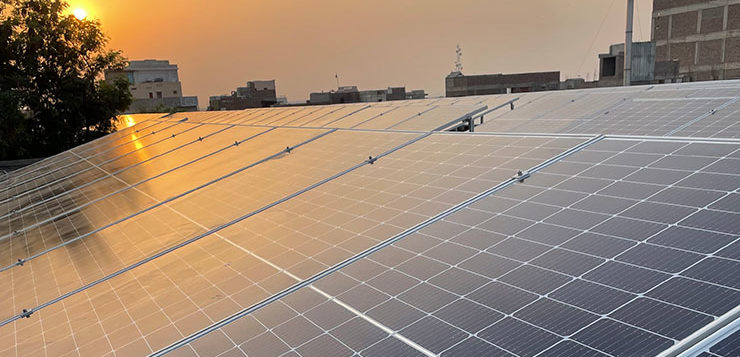Rooftop solar is a fantastic idea… if you don’t really care about the environment or climate change, or your neighbours, or the long-term affordability of power. Geoff Russell breaks down the numbers on why small-scale solar projects are doing big scale damage.
The International Energy Agency (IEA) recently issued “Electricity 2024”, an analysis of the current global state of electricity production and predictions through to 2026.
Europe is in a mess. After a couple of decades crowing about how cheap wind and solar are, the war in Ukraine has shown them that when push comes to shove, reliable electricity – the stuff that is there when you want and need it, especially when it is snowing and -20°C – is very much more valuable than weather dependent electricity which arrives when it feels like it.
Everybody could make much cheaper cars if they didn’t have to start for days at a time, or operate at night (because headlights).
There is also a stubborn and growing gap between the price of electricity, as delivered, and the price of generation.
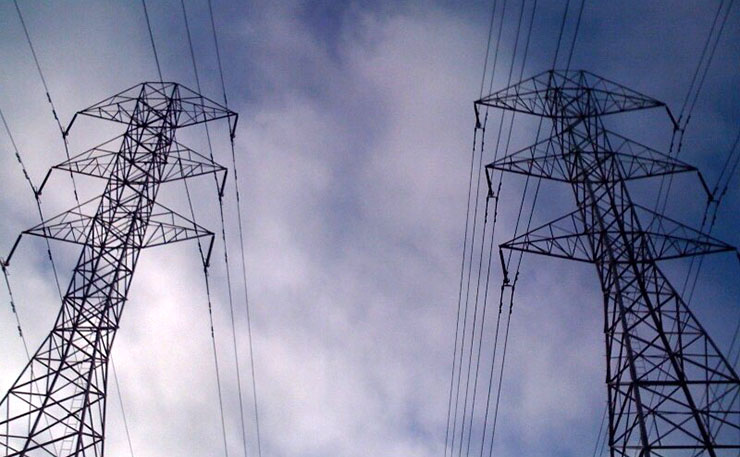
So after a couple of decades of renewable expansion, the wholesale price of electricity in the EU is still almost double that of the US and China; and that’s after dropping 50% from its peak in 2022 after Vladimir Putin’s invasion of Ukraine. How can you spend billions on cheap power and still have sky high prices? Because generation is only one of many factors determining costs, and a relatively minor one at that.
The result of high electricity prices in the EU has been deindustrialisation, at the worst possible time.
Deindustrialisation in the EU
Electricity use in the European Union is falling, down by over 3% in both 2022 and 2023. This is despite the increasing demands of things like data centres and electric vehicles.
The calls to “electrify everything” are failing. The IEA Net Zero by 2050 (NZ2050) plan calls for electricity to supply 30 per cent of primary energy by 2030, just seven years away. But its supply percentage has only jumped 2%, from 18% to 20%, in the eight years from 2015 to 2023.
For the past 20 years, few have bothered if heavy industry migrated to poorer countries… like moving from Europe to China. Few have bothered if nobody but the Chinese can make solar panels and car sized batteries. Just so long as they were cheap. Globalisation was a win-win. Inequality declined globally, even as it increased within countries.
But geopolitics has changed.
Russia has reasserted a once common view of international borders; that they were always guidelines, not rules, and could be changed by force as required. This raises fears about various other countries following suit, particularly China with its claims to Taiwan, but also Venezuela with its claims to an area of Guyana… following the discovery of an obscene amount of oil.
Suddenly the geographical paths of global supply chains start to matter, and the deindustrialisation of Europe due to energy prices is of great importance. Suddenly, the local capacity to transform great hunks of steel into tanks and artillery shells matters.
We can all rail against this tragedy, but that won’t make it go away.
The IEA report details where Europe has been saving energy, aka deindustrialising. It’s in the foundational but energy-intensive processes that nobody thinks about. Like the divesting of some processes by German global giant BASF, the largest chemicals producer in the world.
Caprolactam won’t mean much to most of us, but it’s a basic chemical used to make all kinds of fibres, plastics, paints and film-like coatings. Ammonia isn’t just stuff to clean toilets, it’s the basis of fertilisers.

“It has been estimated that about half of the nitrogen in our eight billion human bodies was pulled from the sky and turned into ammonia and then fertiliser by chemical companies. Nitrogen is the key component of protein. So if you reduce this fertiliser production, then you need to appropriate more wildlife habitat to expand the area we farm. Artificial fertiliser is the unsung hero of both wildlife habitat protection and human nutrition.
Metal production, including aluminium, steel, zinc and silicon have also been hit. Australia should understand this: we’ve lost two aluminium smelters in the past 15 years.
Renewable expansion in Australia and South Australia
The IEA gives Australia a mention for its record renewable expansion. My home state of South Australia gets a mention within mentions. The IEA point out that the hourly wholesale price of electricity was in the negative 25 per cent of the time in SA. They also mention that futures contracts for electricity in 2024 traded at AUD$90/MWh, 10 per cent higher than in 2023. Oops.
The traders get it. Focusing on periods of negative and cheap prices is a classic rose-coloured glasses mistake, also known as confirmation bias. Traders wanting to make accurate predictions factor in all those unremarked upon periods when the price of electricity was much higher. After 500,000 Victorians lost power on February 13, the price of electricity in that state stayed at the legislated market limit ($16,600/MWh) for hours.
The underlying price, which would have been paid if not for the legislated limit, was over $400,000/MWh.
The mining supply chain is struggling
Global geopolitics look like making everything worse. Apart from people dying under barrages of bombs, bullets and the choking of essential services in three big wars, Ukraine, Gaza and Sudan, global geopolitics is screwing up the task of digging up the 70,000-150,000 tonnes of stuff you need for every one of the 26,000 Gigawatt-hours of solar and wind power required for plans like the IEA net zero by 2050 energy plan; not to mention the additional even larger amounts of copper, steel, and aluminium required to connect it all together.
Do the math and you’ll understand why so many big mining magnates have suddenly become ‘born-again Greenies’.
But the mining industry is tough. For anybody not paying attention, it’s gone from boom to bust over the past few years. The Economist ran the numbers this week on the crash in investment for the world’s 40 biggest mining companies. If you are on the ball you will have done a quick multiplication, while reading the last paragraph, of 100,000 by 26,000 and got 2.6 billion tonnes of stuff. That ignores the grid and transmission upgrades and also the batteries and the rebuilding of carbon emitting non-electrical manufacturing sectors; steel and aluminium infrastructure and much else besides.
The Economist article cited an estimate that the full total of additional metal required for decarbonisation was 6.5 billion tonnes by 2050.
The article used an interesting measure of mining investment levels.
Think about your ‘before tax’ income. What proportion of it do you invest in education and skills development? Was it 5%? Or perhaps 20%? What if you sell TVs for a living and you decide you’d rather be a mining engineer. How much would you need to invest? You’ll be up for some $8,500 ($51,000 for an International Student) in university fees over the four or so years it will take. Your retail sector job will be giving you an average annual wage before tax of around $80,000. So swapping your job to cash in on the mining boom is going to cost you a few percent of that income over four to five years, plus plenty of hard study. If it’s what you want to do, it’s not a big investment or risk.
But what if you needed to invest 30% or 40% of your income? And what if there was a reasonable likelihood of failure? Would you still do it?
Mining companies are, judging by The Economist data on the 40 biggest ones, currently spending about 25% of their pre-tax income on new projects. That may sound like a lot, it’s certainly far more than any TV salesman wanting to become an Engineer. But it’s way down on the close to 80% they spent back in 2013! Here’s a chart redrawn from their data:
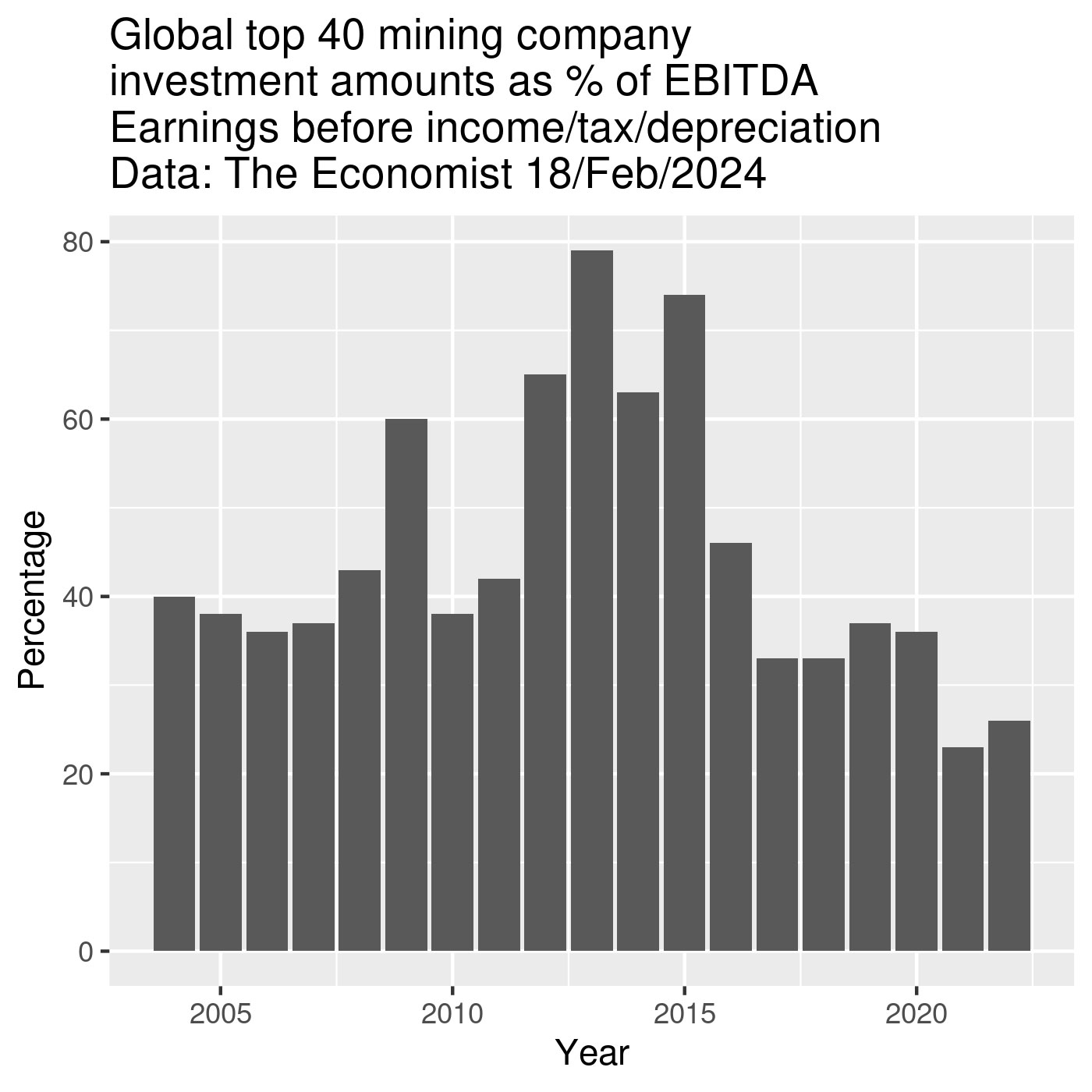
During that spending boom, there were some enormous losses. BHP wrote down it’s nickel business in WA by $2.5 billion (with a ‘b’!). There have been mergers, take overs and all the other machinations that occur when people bet big and lose. Decarbonisation starts with big mines, and moves on to some pretty ugly dirty industries before perhaps ending in that super shiny Tesla on your driveway.
Plenty of thinktanks, driven by government concern over strategic minerals, have been analysing the problem; namely how to produce that 6.5 billion tonnes of metals needed to decarbonise the energy (not just electricity) system by 2050.
It’s a massive task. And the electricity side of the problem is being made larger than it need be by many people opting to do it with the most resource inefficient, expensive and destructive method we have at our disposal; rooftop solar power.
Exacerbating a tough problem with the wrong technology
A recent guest article by Tristan Edis on the electricity blog WattClarity demonstrated the problem. It starts by noting that “other power generators struggle and fight to remain online in the face of a flood of rooftop solar generation. If that’s the case with about 20,000MW of rooftop solar capacity in the National Electricity Market (NEM) then imagine what things will look like with 48,000MW to potentially even 98,000MW”.
Note the lack of question mark at the end. Read the article and you won’t find an answer either.
The article asks how high the capacity of rooftop solar might go, but doesn’t think (much) about the implications for anybody except the owner. The article doesn’t think about the supply chains required to supply either the solar panels, or the metals for the batteries it thinks will be installed by owners of rooftop systems, because that’s the logical thing for any person with buckets of money to do. Basically the article is for and about people whose primary thought is: “What’s best for me, me and me?”. And the answer is obvious, a bigger photovoltaic (PV) system and the biggest battery they can afford, to go with the biggest electric vehicle(s) in the biggest garages in the biggest house they can build.
I’m not being gratuitously insulting. Edis claims that the solar capacity is up by 380 per cent over the past decade, with only five per cent more rooftops having solar. People are swapping small solar systems for bigger ones. Edis also claims that PV systems last a long time. But that’s not of much relevance when, as he says, people don’t wait for them to wear out.
Such people typically also expect that the grid will be upgraded, without any costs to them, to cover the loads they place on it by demanding that they sell any excess electricity for top dollar.
Edis claims that distribution networks have demonstrated a capability to manage very high levels of household solar adoption. His focus on NSW and Victoria is interesting: anybody paying attention knows that it is South Australia who is at the bleeding edge of rooftop PV expansion and renewables generally. The following chart tells the story.
SA’s solar and wind penetration is way ahead of the Australian average and also way ahead of Germany, often touted as a renewable leader. The “kWh/person” shading is the balance of electricity generation… fossil fuels.
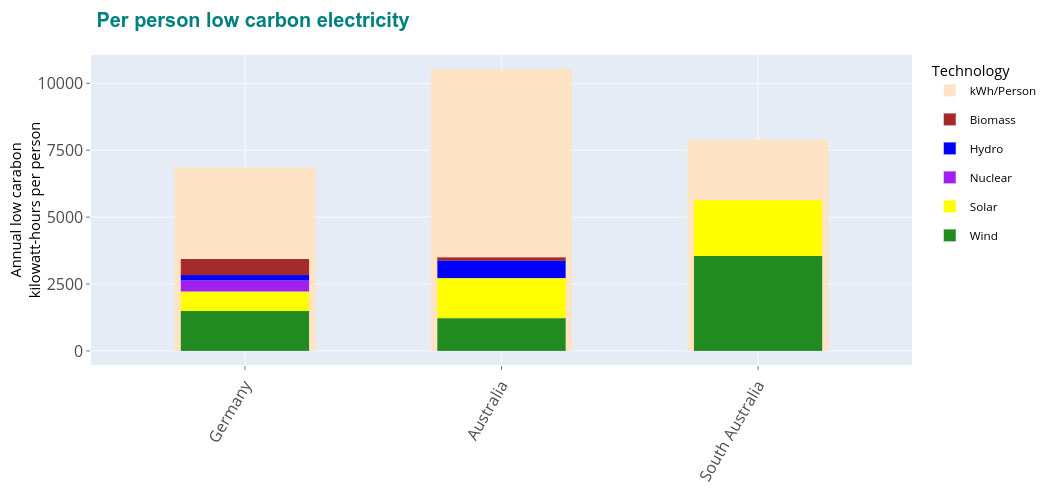
Edis reckons there is no evidence of “solar traffic jams”; aka congestion, which he reckons is indicated by high voltages.
Where would you expect to see this? South Australia obviously.
And you do.
SA Power Networks Distribution and Planning Report (DAPR) (2023/4) names substations and lines which are congested and says very clearly that the 5kW per phase export limit was unsustainable. The “export limit” is the power the grid will accept from customers. The previous edition (2022/3) of the DAPR carried a little more detail:
“modelling performed under the SA Power Networks LV Management Strategy as part of the SA Power Networks 2020-2025 Regulatory Proposal showed that the distribution network can typically only host between 1-2 kW per customer before the operating limits of the system are breached.”
This is clearly incompatible with very many people installing 6-10kW rooftop PV systems.
SA Power Networks now has a scheme of ‘flexible’ exports, whereby they control what people export. SAPN can and does disconnect people, thereby preventing them exporting power when the grid is congested; or just to keep it stable when it is at risk of total collapse.
In December 2022 when SA was cut-off from the rest of the eastern grid, considerable amounts of rooftop solar exports were blocked to keep the grid stable.
The report also confirms that rooftop solar is contributing to over-voltage situations on the transmission system. This is the “high voltage” situation Edis reckons isn’t happening.
Think about this. The “transmission” system is the big high voltage trunk lines. So the problems in the distribution (the stuff near your house) system is pushing back and causing problems in the transmission system.
Victorian flexible exports and peer to peer trading
And in Victoria? AusNet is the distribution network provider for eastern Victoria; there are 4 others.
AusNet’s latest DAPR report contains a whole section on the stuff that Edis reckons isn’t happening. AusNet is implementing a Flexible Export system similar to the one already operating in SA. Here’s what they say:
“AusNet have been progressing the Flexible Exports program to allow solar customers to export energy to the network, particularly in areas where technical limitations have resulted in zero or near-zero energy export limits.”
Clearly, parts of the AusNet grid can’t handle any rooftop PV exports. Edis’ portrayal of a grid which is handling renewables effortlessly is simply the result of him not reading the relevant reports.
The electricity haves and have nots
Edis and other rooftop PV advocates clearly want electricity to switch from being an efficient service that serves the community reasonably equitably, to a market that those in the know can milk. Electricity used to work pretty much the same whether you lived in a block of flats or on a block of land. But there is now a very big advantage to having a McMansion style roof which can handle a big bank of panels feeding into one or more 100kg Tesla Powerwall batteries in one or more of your garages.
During the aforementioned blocking of rooftop solar exports in December 2022, there was plenty of pushback from those who lost money.
AusNet are assisting those wanting to exploit their existing wealth to make more. Page 130 of the DAPR describes how AusNet wants to assist peer-to-peer trading, selling your extra power to somebody else, probably at a price set by their desperation on a windless night when the wholesale price of the public grid is sky high.
Will this herald a new era of generosity in Australia? Will people just give away excess electricity when times are good? Will neighbourhoods barter kWh for apples and apricots? I suspect not. There are too many layers of rent-seekers looking for a cut.
So the software that eventually controls these markets will optimise income for owners, with some kind of licence fee going to the providers of software. There are plenty of smart young entrepreneurs thinking that a few percent of a really large number is a good way to become the next Atlassian.
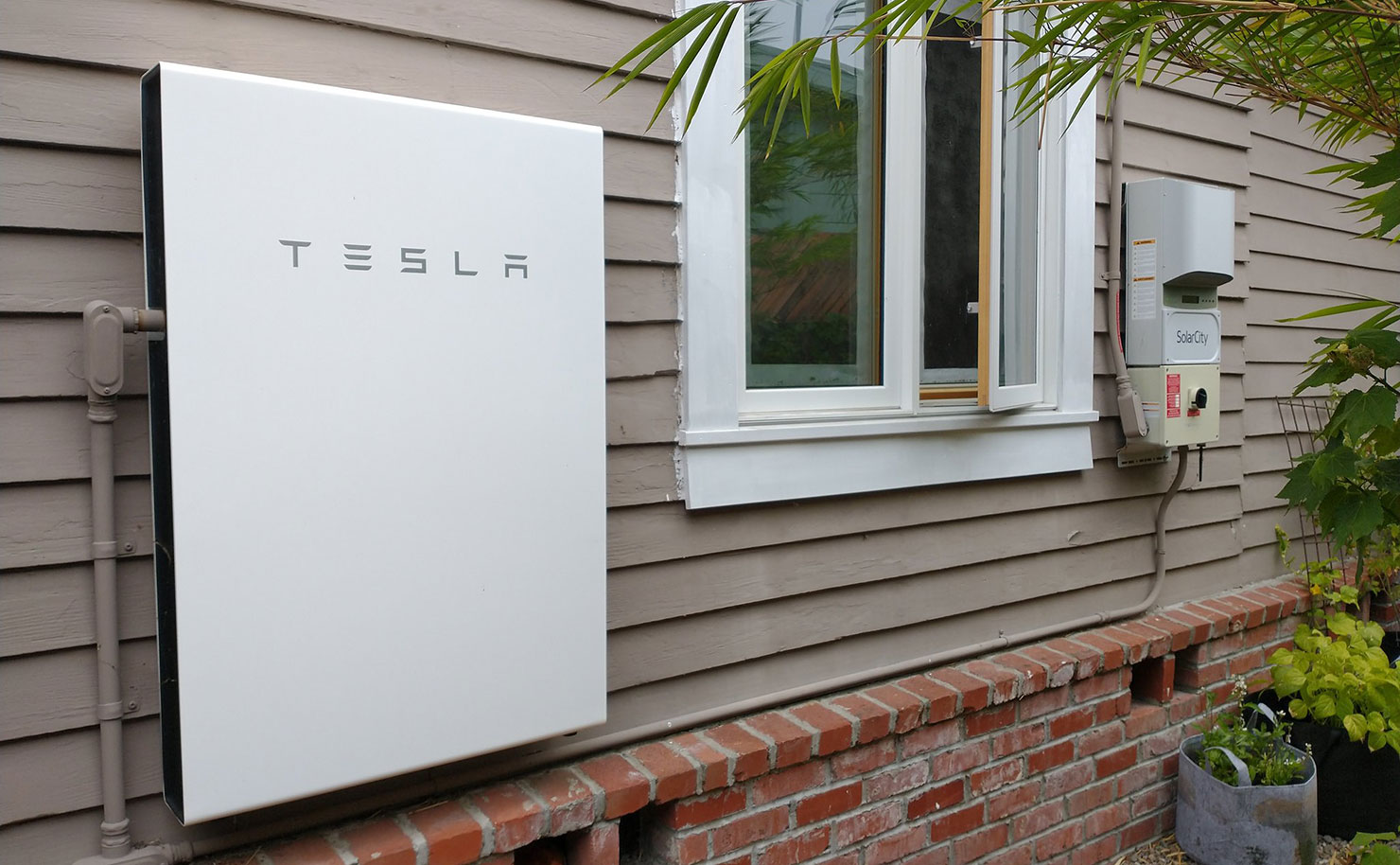
These kinds of schemes are like giant electromagnets for schemers, dreamers and scammers. They’ll sell it using slogans about taking control out of the hands of big business and returning it to communities. The details will be in long contracts that nobody reads that are full of sliding scales which keep those small percentages flooding from credit cards to bank accounts.
Plenty of intrinsically unselfish people are caught up in this scam. For a couple of decades successive governments (here and elsewhere) have failed to efficiently decarbonise either our energy or agricultural systems, leaving a public desperate to act. What government wouldn’t love it that rooftop solar market advocates have legitimised government inaction? It’s a match made in heaven; pity it won’t work.
The problem is the lack of end-game.
The reason is staring Edis in the face. What will happen to centralised generators? Rooftop solar makes every other form of electricity generation inefficient and unprofitable. It will do to electricity exactly what cars have done to public transport.
Want to build a wind farm? Then look forward to not selling anything you produce during daytime because of rooftop solar.
Want to build a solar farm with a massive battery? Then look forward to not selling much of what you produce and store during daytime because of rooftop solar. After sundown you’ll only be able to sell to the poor suckers without a big battery or a big electric vehicle (EV) in their big garage. Still if you jack up the prices high enough, you may be able to cover the loans you took out to cover construction. More than likely, the only people in the electricity game outside of home owners will be those who wangle public money of some kind.
Electricity generation will be like public transport. Subsidised to limp along providing a very basic service at best.
Can we provide an equitable system that serves everybody without big centralised providers? It hasn’t worked with transport. It hasn’t worked with electricity; and it would have if it was easy.
It hasn’t worked with computing. I remember all the talk of distributed computing and the demise of the main-frame. Main-frames and large companies just morphed into data-centres and got bigger. Nobody wants to go back to the bad old days of everybody managing their local computing system and it’s backups and upgrades and all those other things the big corporates manage in the cloud. But they reckon rooftop solar will be the exception.
It won’t.
Fiddling while we burn
After dietary change, decarbonising electricity is the second simplest of the big transitions we need to make, and we are failing dismally. The wind and solar decarbonisation pathway is bad enough in its need for batteries and a vastly transformed grid, but rooftop solar makes a bad system even worse.
We will have to decarbonise twice. We’ll get to 80-90 percent renewables and be hit by crippling grid costs and complexities and have to do what we should have done in the first place; build a bunch of nuclear reactors.
Except we’ll have wasted 20 years arriving at the decision.
Donate To New Matilda
New Matilda is a small, independent media outlet. We survive through reader contributions, and never losing a lawsuit. If you got something from this article, giving something back helps us to continue speaking truth to power. Every little bit counts.

